On This Page:
- Background
- Measure
- Healthy People 2030 Target
- Data Source
- Trends and Most Recent Estimates
- Related Cancers
- Additional Information
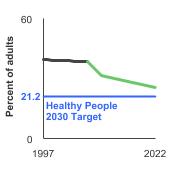
Background
Maintaining a healthy lifestyle has the potential to reduce both cancer- and non-cancer-related morbidity. In particular, physical activity may reduce the risk of several types of cancer, including bladder, breast, colon, endometrium (lining of the uterus), esophagus (adenocarcinoma), kidney, and stomach. Being active may help to prevent weight gain and obesity, which can reduce the risk of developing cancers that have been linked to excess body weight. Physical activity may also lower a person’s risk of health problems such as heart disease, high blood pressure, diabetes, and osteoporosis (bone thinning).
Physical activity also improves the quality of life among cancer patients and survivors. For people with colorectal cancer, women with breast cancer, and men with prostate cancer, greater amounts of physical activity are associated with reduced risk of mortality from the original type of cancer. For people with colorectal cancer and women with breast cancer, greater amounts of physical activity are also associated with reduced risk of all-cause mortality.
Several national groups offer recommendations for engaging in regular physical activity. The U.S. Department of Health and Human Services recommends that adults get at least 2.5 hours of moderate-intensity or 1 hour and 15 minutes of vigorous-intensity aerobic activity each week. Adults should also do muscle-strengthening activities on 2 or more days a week.
Measure
Percentage of adults aged 18 years and older who reported no leisure-time physical activity during the past month and percentage of adults who meet both the aerobic and muscle-strengthening guidelines.
Data Source
Centers for Disease Control and Prevention, National Center for Health Statistics, National Health Interview Survey 1992–2022.
Refer to the Data Sources page for more information about data collection years 2019+.
Healthy People 2030 Target
- Reduce the percentage of adults who engage in no leisure-time physical activity to 21.2 percent.
- Increase the proportion of adults who meet the objectives for aerobic physical activity and for muscle-strengthening activity to 28.4 percent.
Healthy People 2030 is a set of goals set forth by the Department of Health and Human Services.
Note: Goals are indicated as blue line on Detailed Trend Graphs.
Trends and Most Recent Estimates
- No Leisure Time Physical Activity
-
- By Sex
-
Percentage of adults aged 18 years and older reporting no physical activity in their leisure time by sex, 1997-2022 Overview Graph Detailed Trend Graphs Most Recent Estimates (2022) Percent of adults 95% Confidence Interval 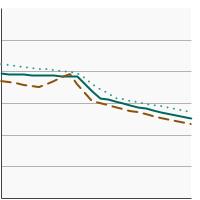

Both Sexes 
26.3 25.4 - 27.2 Male 
24.4 23.3 - 25.5 Female 
28.1 27.0 - 29.3 - By Race/Ethnicity
-
Percentage of adults aged 18 years and older reporting no physical activity in their leisure time by race/ethnicity, 1997-2022 Overview Graph Detailed Trend Graphs Most Recent Estimates (2022) Percent of adults 95% Confidence Interval 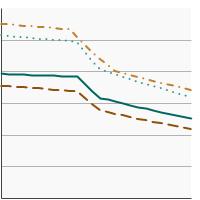

All Races/Ethnicities 
26.3 25.4 - 27.2 Non-Hispanic White 
22.8 21.8 - 23.8 Non-Hispanic Black 
32.3 30.1 - 34.6 Hispanic 
35.3 33.4 - 37.2 - By Poverty Income Level
-
Percentage of adults aged 18 years and older reporting no physical activity in their leisure time by poverty income level, 1997-2022 Overview Graph Detailed Trend Graphs Most Recent Estimates (2022) Percent of adults 95% Confidence Interval 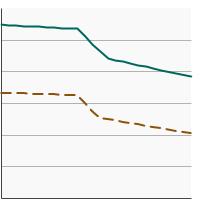

<200% of federal poverty level 
39.5 37.9 - 41.0 >=200% of federal poverty level 
21.6 20.8 - 22.5 - By Education Level
-
Percentage of adults aged 25 years and older reporting no physical activity in their leisure time by highest level of education obtained, 1997-2022 Overview Graph Detailed Trend Graphs Most Recent Estimates (2022) Percent of adults 95% Confidence Interval 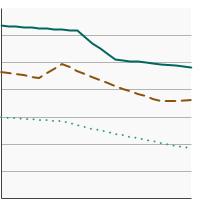

Less than High School 
50.2 47.3 - 53.0 High School 
36.7 35.0 - 38.5 Greater than High School 
19.7 18.9 - 20.6
- Meet Federal Guidelines
-
- By Sex
-
Percentage of adults aged 18 years and older who meet current Federal guidelines for aerobic and muscle-strengthening physical activity by sex, 1997-2022 Overview Graph Detailed Trend Graphs Most Recent Estimates (2022) Percent of adults 95% Confidence Interval 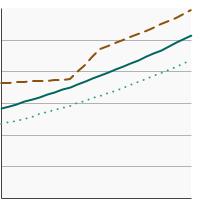

Both Sexes 
25.3 24.5 - 26.1 Male 
29.4 28.4 - 30.5 Female 
21.3 20.4 - 22.3 - By Race/Ethnicity
-
Percentage of adults aged 18 years and older who meet current Federal guidelines for aerobic and muscle-strengthening physical activity by race/ethnicity, 1997-2022 Overview Graph Detailed Trend Graphs Most Recent Estimates (2022) Percent of adults 95% Confidence Interval 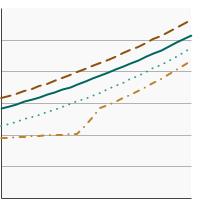

All Races/Ethnicities 
25.3 24.5 - 26.1 Non-Hispanic White 
27.1 26.1 - 28.1 Non-Hispanic Black 
23.8 21.9 - 25.9 Hispanic 
20.9 19.4 - 22.4 - By Poverty Income Level
-
Percentage of adults aged 18 years and older who meet current Federal guidelines for aerobic and muscle-strengthening physical activity by poverty income level, 1997-2022 Overview Graph Detailed Trend Graphs Most Recent Estimates (2022) Percent of adults 95% Confidence Interval 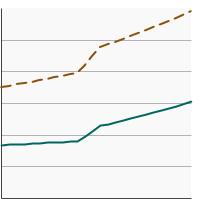

<200% of federal poverty level 
14.7 13.7 - 15.7 >=200% of federal poverty level 
29.2 28.3 - 30.1 - By Education Level
-
Percentage of adults aged 25 years and older who meet current Federal guidelines for aerobic and muscle-strengthening physical activity by highest level of education obtained, 1997-2022 Overview Graph Detailed Trend Graphs Most Recent Estimates (2022) Percent of adults 95% Confidence Interval 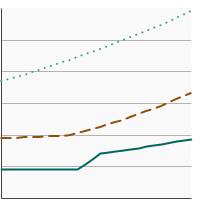

Less than High School 
7.9 6.4 - 9.7 High School 
15.4 14.2 - 16.7 Greater than High School 
29.0 28.1 - 29.9
Additional Information
- Physical Activity and Cancer. National Cancer Institute.
- Nutrition, Physical Activity, and Obesity. Centers for Disease Control and Prevention.
- Physical Activity. Centers for Disease Control and Prevention.
- Physical Activity Guidelines for Americans. U.S. Department of Health & Human Services.
- Diet, activity and cancer. World Cancer Research Fund and the American Institute for Cancer Research.
- Physical Activity Evidence-Based Programs Listing. National Cancer Institute.
- ACS Guidelines on Nutrition and Physical Activity for Cancer Prevention. American Cancer Society.
- Community Preventive Services Task Force Findings: Physical Activity. The Community Guide.
- Move Your Way® Community Resources. U.S. Department of Health and Human Services.
- Guidelines on Physical Activity and Sedentary Behavior. World Health Organization.
- Physical Activity Guidelines for Americans Midcourse Report: Implementation Strategies for Older Adults. U.S. Department of Health and Human Services.
- 2018 Physical Activity Guidelines Advisory Committee Scientific Report. Part F. Chapter 4. Cancer Prevention. US Department of Health and Human Services. F4-2 – F4-67.
- Non-occupational physical activity and risk of cardiovascular disease, cancer and mortality outcomes: a dose–response meta-analysis of large prospective studies. Garcia L, Pearce M, Abbas A, et al. Br J Sports Med. 2023;57:979-989.
- Amount and Intensity of Leisure-Time Physical Activity and Lower Cancer Risk. Matthews CE, Moore SC, Arem H, et al. J Clin Oncol 2020; 38(7):686-697.
- Physical Activity in Cancer Prevention and Survival: A Systematic Review. McTiernan A, Friedenreich CM, Katzmarzyk PT, et al. Med Sci Sports Exerc 2019; 51(6):1252-1261.
- Associations of Accelerometer-Measured Physical Activity and Physical Activity-Related Cancer Incidence in Older Women: Results from the WHI OPACH Study. Parada H. Jr, McDonald E, Bellettiere J, et al. Br J Cancer. 2020;122(9):1409-1416.
- American College of Sports Medicine Roundtable Report on Physical Activity, Sedentary Behavior, and Cancer Prevention and Control. Patel AV, Friedenreich CM, Moore SC, et al. Med Sci Sports Exerc 2019; 51(11):2391-2402.
- Vigorous Intermittent Lifestyle Physical Activity and Cancer Incidence Among Nonexercising Adults: The UK Biobank Accelerometry Study. Stamatakis E, Ahmadi MN, Friedenreich CM, et al. JAMA Oncol. 2023;9(9):1255–1259.
- Association of Leisure Time Physical Activity Types and Risks of All-Cause, Cardiovascular, and Cancer Mortality Among Older Adults. Watts EL, Matthews CE, Freeman JR, et al. JAMA Netw Open. 2022 Aug 1;5(8):e2228510.
- FastStats – Exercise or Physical Activity. Centers for Disease Control and Prevention.